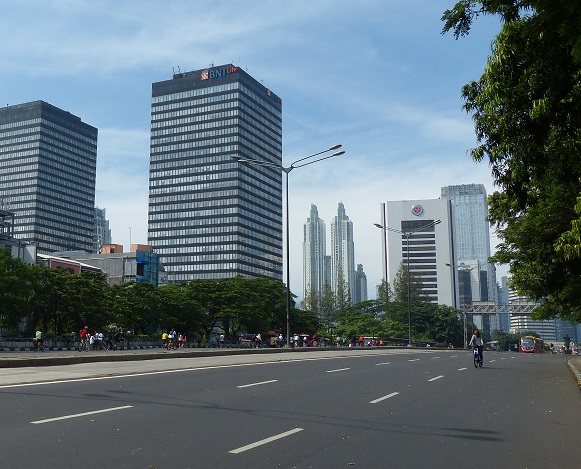GDP Growth Indonesia Update: What about Economic Growth in Q3-2014?
Economic growth in Indonesia is expected to continue to slow in the third quarter of 2014 according to the country’s central bank. Bank Indonesia Deputy Governor Perry Warjiyo said on Thursday (30/10) that the institution believes gross domestic product (GDP) growth of Southeast Asia’s largest economy to reach 5.1 percent year-on-year (y/y) in Q3-2014, similar to the GDP growth result in the previous quarter (5.12 percent, y/y). Main reason for this slowing pace is the sluggish global economy and particularly the case of China.

The economy of China only expanded 7.3 percent (y/y) in the third quarter of 2014, the slowest growth pace in five years, thus fuelling concerns that the world’s second-largest economy may fail to achieve its 7.5 percent annual growth target for full-year 2014. Being a major trading partner of Indonesia, slowing economic growth in China - implying declining demand for Indonesian exports - impacts negatively on the economic performance of Indonesia. Moreover, weakening demand from China results in downward pressure on global commodity prices. Indonesia's export performance is highly dependent on commodities as these account for around 60 percent of the country’s total exports. This overdependence on commodity exports (particularly raw commodities) implies that the country is more susceptible to the effects of volatility in global commodity prices. Therefore, the Indonesian government targets for more domestic processing facilities in an effort to enhance value-added industries in the mining sector through Law 4/2009 on Mineral and Coal Mining.
Warjiyo said that for every one percentage point decline in economic growth in China, Indonesia’s economic growth will slow by 0.5 percent. He added that, although Indonesian exports to China have been slowing, exports to India have increased and can therefore somewhat offset the negative impact of slowing growth in China.
In 2015, the economy of Indonesia will face one major challenge i.e. higher US interest rates. After the US Federal Reserve has ended the monthly bond-buying program (quantitative easing), it will not take long before interest rates are raised in the world’s largest economy. Higher interest rates in the USA make it more attractive for investors to move funds to the USA. When US interest rates are low (in combination with the large US dollar supply amid the quantitative easing program) many cheap dollars were invested in lucrative (yet riskier) assets in emerging economies including Indonesia.
However, capital outflows triggered by higher US interest rates can be somewhat curbed provided that Indonesia can strengthen the country’s economic fundamentals. A serious weakness of Indonesia is the current account deficit which hit 4.27 percent of GDP in the second quarter of 2014. Moreover, inflation may accelerate sharply after the new government raises prices of subsidized fuels before the year-end (a move which is expected to curb the wide current account deficit). A wide, unsustainable current account deficit and high inflation make Indonesia vulnerable to capital outflows in times of global shocks or uncertainty (such as the looming higher US interest rates).
Regarding full-year 2014, the central bank of Indonesia expects a GDP growth pace of 5.2 percent.
Meanwhile, Singapore-based DBS Bank is more optimistic about Indonesian GDP growth in the third quarter of 2014. DBS Bank economist Gundy Cahyadi expects economic growth to accelerate to 5.4 percent (y/y) in Q3-2014 despite the negative impact of slowing growth in China. Cahyadi said that economic growth is supported by stable domestic consumption (which traditionally accounts for over half of total economic growth in Indonesia). However, robust domestic demand also causes more imports of capital goods. Import growth may reach 7.4 percent in Q3-2014, while exports are likely to continue to slow according to Cahyadi.
As can be seen in the tables below, economic growth in Indonesia has been slowing since 2011. This is partly the result of external influences (the weak global economy) but also due to the internal rebalancing of the economy. Bank Indonesia has raised its key interest rate (BI rate) gradually through 2013 from 5.75 percent to 7.50 percent in an attempt to combat high inflation (that emerged after subsidized fuel prices were raised by an average of 33 percent in June 2013), as well as to curb the wide current account deficit and support the rupiah exchange rate (which had depreciated over 25 percent against the US dollar in 2013 amid the looming ending of the US bond buying progam).
Indonesia's Quarterly GDP Growth 2009–2014 (annual % change):
| Year | Quarter I |
Quarter II | Quarter III | Quarter IV |
| 2014 | 5.22 | 5.12 | ||
| 2013 | 6.03 | 5.89 | 5.62 | 5.78 |
| 2012 | 6.29 | 6.36 | 6.16 | 6.11 |
| 2011 | 6.45 | 6.52 | 6.49 | 6.50 |
| 2010 | 5.99 | 6.29 | 5.81 | 6.81 |
| 2009 | 4.60 | 4.37 | 4.31 | 4.58 |
Source: Statistics Indonesia (BPS)
Gross Domestic Product of Indonesia 2006-2013:
| 2006 | 2007 | 2008 | 2009 | 2010 | 2011 | 2012 | 2013 | |
| GDP (in billion USD) |
285.9 | 364.6 | 432.1 | 510.2 | 539.4 | 706.6 | 846.8 | 878.0 |
| GDP (annual percent change) |
5.5 | 6.3 | 6.1 | 4.6 | 6.1 | 6.5 | 6.2 | 5.8 |
| GDP per Capita (in USD) |
1,643 | 1,923 | 2,244 | 2,345 | 2,984 | 3,467 | 3,546 | 3,468 |
Sources: World Bank, International Monetary Fund (IMF) and Statistics Indonesia (BPS)
Key Findings:
• GDP growth of Indonesia has been slowing since 2011 due to the sluggish global economy and internal rebalancing
• China’s slowing economic growth has a severe negative impact on Indonesia as the latter’s export performance weakens
• Indonesia’s GDP growth to expand in the range of 5.1 to 5.4 percent (y/y) in the third quarter of 2014
Bahas
Silakan login atau berlangganan untuk mengomentari kolom ini

